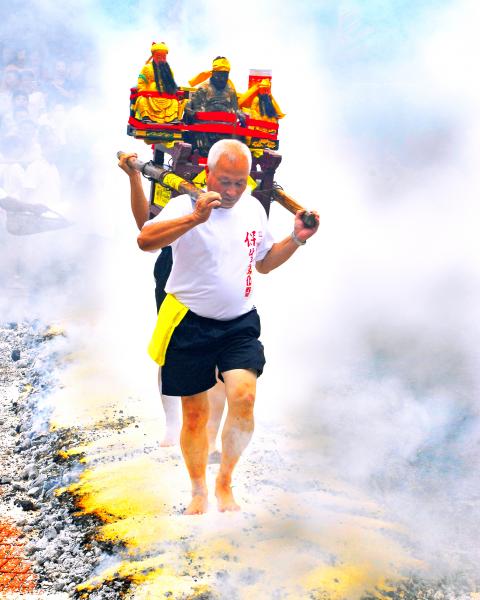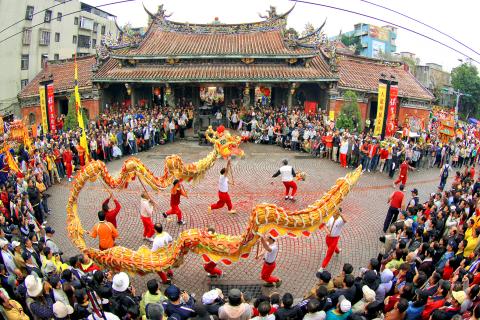While fire-walking ceremonies may have become de rigueur as a corporate team-building activity, Bao-an Temple’s (保安宮) ritual follows a time-honored tradition of purifying Taipei City’s Dalongdong (大龍峒) district, where the temple is located.
Along with exorcisms, pilgrimages, folk operas and purification ceremonies, the rite is part of the temple’s 2012 Folk Art Festival (2012民俗藝術節, previously known as the Baosheng Cultural Festival), which begins tomorrow and is being held to celebrate the birthday of Baoshengdadi (保生大帝, also known as the God of Medicine), the temple’s patron deity, who is believed to be 1,034 years old.
Some fire-walking (過火) participants have been known to become overzealous in their desire to purify. Joey Ho (何良正), a spokesman for Bao-an Temple who has been giving tours of the place of worship for close to two decades, told the Taipei Times that during a previous festival a believer walked in the wrong direction because “he fell into a trance after being possessed [by a god].”

Photo Courtesy of Bao-an Temple
Quickly alerted to his error by the assembled crowd, the man eventually “walked the proper path.” Ho said that correctly performing the ritual shows respect to Baoshengdadi and helps to avoid dangerous collisions in the center of the 10m-long pile of hot coals.
Although he won’t be among the estimated 40 believers who, in groups of two or more, will carry small and large sedan chairs over the embers, Ho will introduce the troupes and stand vigil to ensure everyone walks in the right direction. Unlike some fire-walking ceremonies in Taiwan, Bao-an Temple doesn’t allow members of the public to have a go. Once the ceremony is completed, however, attendees are free to collect the burned ghost money, which they can use as a talisman.
The fire-walking ceremony will be held at 1pm on April 5, which is, according to the temple, Baoshengdadi’s official birthday. Ho says arriving an hour early will secure a good spot to watch from.

Photo Courtesy of Bao-an Temple
Also not to be missed is the “deities parade” (遶境踩街) — an inspection tour of the area by the Eight Generals (八家將), dragon dancers and martial lictors — and the Fire Lion (施放火獅) ritual, which involves setting off fireworks that have been stuffed in a fabricated lion’s body. Both rituals take place on April 4. The parade begins at 1pm and the fireworks display, which Ho says drives away evil spirits and pestilence and is almost as spectacular as the Yenshui Beehive Fireworks Festival (鹽水蜂炮), starts at 7pm.
Beginning tomorrow, the temple will close its doors for five consecutive days to perform “completion rituals” (?恩圓醮) to thank Bao-an’s many enshrined deities for protecting the temple during renovations that were completed in 2003 and helped it to win the UNESCO Asia-Pacific Heritage Award that year.
“Even the president won’t be allowed to enter the temple during the completion rituals,” Ho quipped.
There will, however, be a number of events out front of the temple during the five-day period. The Shin-Chung Taiwanese Opera Troupe (薪傳歌仔劇團), National Guoguang Opera Company (國立國光歌劇團) and Chen Meiyun Opera Troupe (陳美雲歌劇團) will perform Taiwanese opera to thank the gods tomorrow, Sunday and Monday, beginning at 7pm each day.
On Tuesday at 7pm, temple priests will cast adrift 160 floating lanterns (施放水燈) from the Dadaocheng Wharf (大稻埕碼頭). Ho said the sight of the lanterns attracts wandering ghosts ashore, that are then enticed back to Bao-an with the promise of food offerings. The Pudu (普渡) Buddhist rite is said to appease the spirits and bring peace and prosperity to local residents.
In addition to providing an up close look at authentic religious customs, the temple is holding a photography competition. Participants are invited to submit photos related to Bao-an Temple between April 10 and April 18. The first-place winner will take home NT$20,000 and have their work included in an exhibition, which will run from April 28 to May 1.
The temple will also hold a “seminar on religious beliefs” on April 15 and provide free guided tours of the temple on April 22. Both the seminar and guided tour will be conducted in Mandarin.
Bao-an Temple began life in 1742 as a shabby wooden structure built by immigrants from Tongan (同安) in China’s Fujian Province. A larger, more substantial temple was built in 1760. Today Bao-an Temple stands as one of finest examples of classical Chinese architecture in Taiwan.
A detailed list of upcoming activities and events can be found at the Bao-an Temple Web site (Chinese only), www.baoan.org.tw/HTML/Yearact/yearact.html. Detailed pamphlets in English and Chinese can be found at the Yuanshan MRT Station’s (圓山捷運站) information booth and at Bao-an Temple, which is located at 61 Hemi St, Taipei City (台北市哈密街61號).

Taiwan Power Co (Taipower, 台電) and the New Taipei City Government in May last year agreed to allow the activation of a spent fuel storage facility for the Jinshan Nuclear Power Plant in Shihmen District (石門). The deal ended eleven years of legal wrangling. According to the Taipower announcement, the city government engaged in repeated delays, failing to approve water and soil conservation plans. Taipower said at the time that plans for another dry storage facility for the Guosheng Nuclear Power Plant in New Taipei City’s Wanli District (萬里) remained stuck in legal limbo. Later that year an agreement was reached

What does the Taiwan People’s Party (TPP) in the Huang Kuo-chang (黃國昌) era stand for? What sets it apart from their allies, the Chinese Nationalist Party (KMT)? With some shifts in tone and emphasis, the KMT’s stances have not changed significantly since the late 2000s and the era of former president Ma Ying-jeou (馬英九). The Democratic Progressive Party’s (DPP) current platform formed in the mid-2010s under the guidance of Tsai Ing-wen (蔡英文), and current President William Lai (賴清德) campaigned on continuity. Though their ideological stances may be a bit stale, they have the advantage of being broadly understood by the voters.

In a high-rise office building in Taipei’s government district, the primary agency for maintaining links to Thailand’s 108 Yunnan villages — which are home to a population of around 200,000 descendants of the Chinese Nationalist Party (KMT) armies stranded in Thailand following the Chinese Civil War — is the Overseas Community Affairs Council (OCAC). Established in China in 1926, the OCAC was born of a mandate to support Chinese education, culture and economic development in far flung Chinese diaspora communities, which, especially in southeast Asia, had underwritten the military insurgencies against the Qing Dynasty that led to the founding of

Artifacts found at archeological sites in France and Spain along the Bay of Biscay shoreline show that humans have been crafting tools from whale bones since more than 20,000 years ago, illustrating anew the resourcefulness of prehistoric people. The tools, primarily hunting implements such as projectile points, were fashioned from the bones of at least five species of large whales, the researchers said. Bones from sperm whales were the most abundant, followed by fin whales, gray whales, right or bowhead whales — two species indistinguishable with the analytical method used in the study — and blue whales. With seafaring capabilities by humans